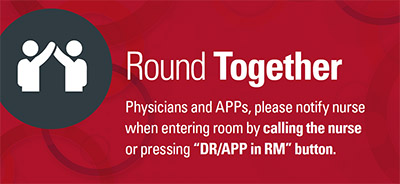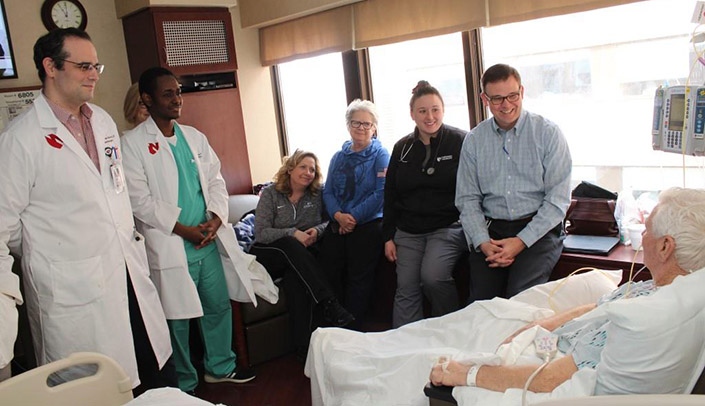The way our patients feel about communication during their hospital stay is moving in the right direction. And it’s not just our patients who feel it. A new initiative, called “Round Together,” is increasing both patient and staff satisfaction.
“Our patients were telling us they feel like we didn’t know each other,” said Sarah Richards, M.D., assistant professor, internal medicine, and medical director of patient experience at Nebraska Medicine. “And that makes it more difficult for them to trust us.”
 |
The group decided on a simple idea to increase the frequency the nurse and the providers are at the bedside at the same time.
“The nurse is there for 12 hours,” Dr. Richards said. “The nurse always knows what’s going on with the patient.”
It’s not a new idea, but barriers have existed that prevented it from being a consistent practice. In August 2018, a “Round Together” pilot was launched on 6 Neuro, led by Scott Diesing, M.D., assistant professor of neurological sciences and medical director of 6 Neuro. It involved posting a card on the patient’s door with instructions on how to reach the patient’s nurse.
“We wanted to show our patients that we know each other and we communicate with one another,” Dr. Diesing said.
Dr. Diesing met with the nurses, surgeons and other providers who round on 6 Neuro to explain the pilot.
“When we began the pilot, we alerted the unit the stroke team was here and ready to round,” Dr. Diesing said.
The unit soon saw their patient satisfaction scores rise, especially for questions regarding how well the doctor and nurse listened.
“We also saw a 10% reduction in pages and Perfect Serve messages,” Dr. Diesing said. “This is something that physicians want, nurses want and the patients want. We just needed a way to execute it.”
“When the physicians and the nurse round in the room with the patient and family, they have a better understanding of the care being provided and the expectations for their stay,” said Mindi Amo, nurse on 6 Neuro. “The open discussion and goal setting puts the patient and family at ease, as they know what is happening for the day. The patient also feels like they have some control in their care since they are part of the discussion. They see us collaborating together which shows that we do really care about them and want the best outcomes.”
The pilot expanded to all the units in Werner Hospital, inside the Fred & Pamela Buffett Cancer Center, and 6/7 Lied. Those units had technology already installed in patient rooms that allowed a provider to simply press a button, alerting the patient’s nurse they were in the room to round.
“Round Together” went live in Bellevue on April 9, along with 4/5 Lied and the Step Down Critical Care Unit (SDCC) at Nebraska Medical Center. The goal is for the rollout to be complete on all inpatient units by the end of May.
“There is so much value in face-to-face communication and it allows for clarifying questions,” Dr. Richards said. “We’ve heard only positive things from nursing and providers who are doing this. It’s a win for everyone.”
Dr. Diesing said that before electronic health records, the nurse and the physician often communicated outside the room as the physician wrote notes in the patient’s paper charts. That interaction declined after going live with One Chart.
“Round Together returns the human touch, the human interaction to the patient’s room,” he said.

This is fantastic. As a family member or a patient seeing everyone involved in the care process together really facilitates a feeling of comfort and caring and a sense that everyone is on the same page. Interactive discussions and questions go a long way toward putting the patient and family at ease. Great job! Congratulations. I wish this were standard practice at every hospital.